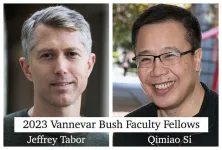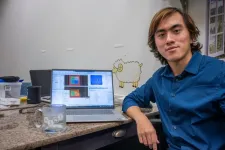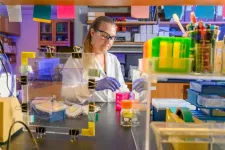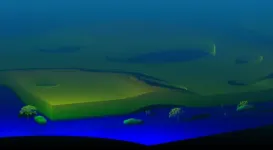(Press-News.org) The world's computing needs have grown exponentially in recent years due to an explosion of technology. To meet the needs for the next technological leap, the scientific community is working to improve current processing capabilities and simultaneously develop entirely new computing methods.
Two new papers from the research group of Jean Anne Incorvia, a professor in the Cockrell School of Engineering’s Chandra Family of Electrical and Computer Engineering, aim to contribute to both of these scientific needs. Together, they offer improvements on current semiconductor technology as well as a nimbler building block to the next generation of computers that think like the human brain.
"We are on the precipice of a new class of computers, and recreating how our brains think is a tremendous research undertaking," said Incorvia. "At the same time, computing techniques we use today aren't going anywhere, so it's important to continue to improve and innovate on the devices that power our current technology."
Logic Problem
New research published in ACS Nano relates to transistors and circuits. Within chips are components called logic gates that interpret digital signals.
These logic gates are transistors that can generally conduct either electrons or holes – which occur when electrons move around within atoms – but not both. In this paper, the researchers linked logic gates together that could conduct both electrons and holes.
They show that this achievement reduces the number of transistors needed in a circuit. And that means more transistors could be packed in to the same space, making it both more efficient and powerful, or the saved space could be used to shrink down the device. They also demonstrate a new circuit that specifically leverages the transistor behavior.
The transistors are made out of ultra-thin two-dimensional materials, which have this naturally "ambi-polar" property that allow them to conduct both holes and electrons. However, they didn't do a great job of it on their own. Refining that capability is a major component of this paper, and through their device engineering they show important XOR, NOR, and NAND circuits without needing any other devices but the ambi-polar transistors. These circuits are the basic building blocks of larger circuits.
"When we think about the future of computing, if we can harness the natural behavior of these 2D materials and scale them, we could cut the number of transistors we need in our circuits in half," Incorvia said.
The researchers showed this capability at a fairly large device size. Their next steps include shrinking the devices down and further reducing the power consumption needed to make them commercially viable chip components.
Noisy Neurons
These findings apply to current computing technology. A second paper published recently in Applied Physics Letters looks at the next generation of computers, those that think more like the human brain.
These neuromorphic devices are better than traditional computers at AI tasks like interpreting images and language processing. In this new paper, the researchers created a new type of artificial neuron – which in the human brain are responsible for sending information between brain cells – using magnetic materials.
Artificial neurons represent a popular area of neuromorphic computing research. What makes these neuron devices stand out is the chaotic nature of their reactions to electric pulses.
They outperformed other artificial neurons as part of neural networks in interpreting images, specifically when the data to be interpreted was noisy. The devices fared better than other artificial neurons in identifying images of blurry shoes, and the gap widened as the blurrier the images became.
"Because the device itself is stochastic in its respond to the input data, it performed better dealing with noisy data sets," Incorvia said.
These neurons could be impactful for "edge computing" uses, where devices need to be smaller, use less power and are far removed from a central computing source like a cloud server. They are also resistant to radiation.
One of the initial applications of this technology could come in outer space, where silicon chips struggle to stand up to the high level of radiation. The ability to deal with radiation as well as messy data could make these neurons ideal for future space-based technology.
Incorvia worked with fellow electrical and computer engineering faculty member Deji Akinwande and Joseph Friedman, associate professor of electrical and computer engineering at The University of Texas at Dallas on the ACS Nano research, which was funded by grants from National Science Foundation and U.S. Air Force Research Laboratory. The rest of the project team includes: Xintong Li and Ethan Rivers from the Chandra Family Department of Electrical and Computer Engineering; Peng Zhou and Xuan Hu from UT Dallas' Department of Electrical and Computer Engineering; and Kenji Watanable and Takashi Taniguchi from the Research Center for Electronic and Optical Materials at the National Institute of Materials Science in Japan.
The Applied Physics Letters research was funded by grants from the National Science Foundation. Incorvia's team on that project is Thomas Leonard, Samuel Liu and Harrison Jin, all from electrical and computer engineering.
END
The present and future of computing get a boost from new research
2023-07-20
ELSE PRESS RELEASES FROM THIS DATE:
The largest study of its kind shows a need for improvement in esophageal cancer screenings
2023-07-20
A new study published in Gastroenterology aims to improve the effectiveness of screening and surveillance practices for early cancer detection in Barrett’s esophagus (BE).
BE is the only identifiable precursor lesion for esophageal adenocarcinoma (EAC), a lethal cancer with increased incidence and mortality rates over the last several decades.
The research, led by faculty at the University of Colorado (CU) Cancer Center, analyzed a large international database of over 20,000 newly diagnosed BE patients in Nordic countries to provide a more accurate look at how many patients have normal ...
Damon Runyon Cancer Research Foundation awards $3.6 million to top clinical investigators
2023-07-20
The Damon Runyon Cancer Research Foundation has named six new Damon Runyon Clinical Investigators. The recipients of this prestigious award are outstanding, early-career physician-scientists conducting patient-oriented cancer research at major research centers under the mentorship of the nation's leading scientists and clinicians.
The Clinical Investigator Award program was designed to increase the number of physicians capable of moving seamlessly between the laboratory and the patient’s ...
Rice researchers earn prestigious Defense Department grants
2023-07-20
HOUSTON – (July 20, 2023) – Rice University professors Qimiao Si and Jeffrey Tabor, are recipients of prestigious Vannevar Bush Faculty Fellowships from the United States Department of Defense.
Si, a theoretical quantum physicist, and Tabor, a bioengineer and synthetic biologist, are among 10 members of the 2023 class of Bush fellows named by the department’s Basic Research Office.
The highly competitive, five-year fellowships are among the federal government’s most prestigious individual research honors. Bush fellowships are awarded annually and include $3 million to pursue ...
Discovery may lead to terahertz technology for quantum sensing
2023-07-20
HOUSTON – (July 20, 2023) – Visible light is a mere fraction of the electromagnetic spectrum, and the manipulation of light waves at frequencies beyond human vision has enabled such technologies as cell phones and CT scans.
Rice University researchers have a plan for leveraging a previously unused portion of the spectrum.
“There is a notable gap in mid- and far-infrared light, roughly the frequencies of 5-15 terahertz and wavelengths ranging from 20-60 micrometers, for which ...
USDA grant funds study of effectiveness of vegetation to curb water pollution
2023-07-20
UNIVERSITY PARK, Pa. — At a time when Pennsylvania is actively working to achieve water-quality improvements to meet the state’s obligations for cleaning up the Chesapeake Bay, a multidisciplinary Penn State research team is studying whether agricultural pollution-prevention devices called riparian buffers are working properly.
Riparian buffers — areas adjacent to streams or wetlands that contain a combination of trees, shrubs and grasses — are managed differently from the surrounding landscape to provide conservation benefits. In agricultural areas, buffers intercept sediment, nutrients, pesticides and chemicals ...
Researchers reveal why obesity makes ovarian cancer more deadly
2023-07-20
Most women with ovarian cancer are diagnosed with the most advanced form of the disease. Less than a third of those diagnosed with the disease survive five years later. As the third most common type of gynecological cancer, it led to more than 200,000 reported deaths globally in 2020 alone, according to a recent study.
In a study published this month in the Journal of Experimental & Clinical Cancer Research, University of Notre Dame researchers in collaboration with NeoGenomics Laboratories ...
Frontiers adopts CRediT to enhance clarity in research authorship
2023-07-20
Frontiers journals have adopted the Contributor Roles Taxonomy (CRediT) to improve the way authors' contributions to research are communicated and acknowledged. The new system replaces the conventional free-text authorship descriptions with a standardized and transparent system that ensures consistency and accuracy in recognizing individual contributions.
CRediT categorizes individual author contributions into well-defined roles and provides a clear, concise framework to describe the diverse contributions made by researchers ...
New findings show private equity investments in healthcare may not lower costs or improve quality of care
2023-07-20
A research team supervised by a health policy researcher at the University of Chicago has found that increasingly common private equity investments in healthcare are generally associated with higher costs to patients and payers. That’s according to a new study published July 19 in The BMJ. The study is thought to be the first systematic review of global private equity ownership trends in medical settings.
“Over the last few decades, private equity activity in healthcare has exploded, with financial institutions buying up hospitals, nursing homes and fertility ...
From chaos to light
2023-07-20
The transition to chaos is ubiquitous in nonlinear systems. Continuous-wave-driven photonic-chip-based Kerr microresonators exhibit spatiotemporal chaos, also known as chaotic modulation instability.
For more than fifteen years such modulation instability states have been considered impractical for applications compared to their coherent-light-state counterparts, such as soliton states. The latter have been the centerpiece for numerous high-profile application demonstrations, from long-range optical communication to photonic computing.
Now, researchers from the group of Tobias Kippenberg at EPFL have found a new way to harness the unique features of chaotic frequency combs to implement ...
UBC Okanagan researchers investigate new use for plastic bottles
2023-07-20
For years, unrecycled plastic bottles have been dumped in landfills. Now, thanks to new research from UBC Okanagan, those bottles may have a second life in that landfill—stabilizing its earth walls.
Used plastic bottles and textiles pose an increasing problem for landfills worldwide. Researchers say nearly a hundred million metric tons of polyethylene terephthalate (PET), also known as microplastics, are produced globally each year—with a fraction of that number being recycled—making it one of the largest sources of plastic waste.
“One ...





